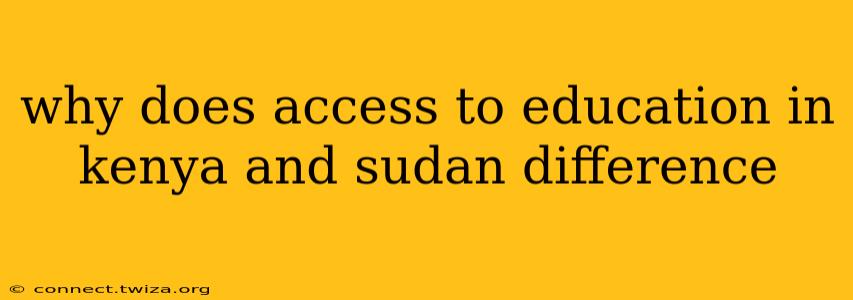Access to education in Kenya and Sudan, while both facing challenges within the broader context of Sub-Saharan Africa, differs significantly due to a complex interplay of political, economic, social, and geographical factors. Understanding these disparities requires a nuanced look at the unique circumstances of each nation.
Historical Context and Political Stability
Kenya, despite its own struggles, has enjoyed relative political stability compared to Sudan for a longer period. This stability, while imperfect, has allowed for more consistent investment in education infrastructure and policy development, albeit with uneven distribution across regions. Sudan, on the other hand, has experienced prolonged periods of conflict, civil wars, and political instability, significantly disrupting educational systems and displacing populations. This instability directly impacts resource allocation, teacher training, and the overall safety and accessibility of schools. The ongoing conflicts in Darfur and other regions continue to severely hamper educational progress.
Economic Factors and Resource Allocation
Kenya's slightly stronger economy allows for greater (though still insufficient) investment in education. While still facing significant challenges, the government allocates a larger portion of its budget to education than Sudan, enabling the construction of schools, provision of learning materials, and teacher salaries (though significant gaps remain). Sudan's struggling economy, hampered by sanctions, internal conflicts, and resource mismanagement, severely limits the government's capacity to invest adequately in education. Limited resources mean fewer schools, insufficient teacher training, inadequate learning materials, and a greater burden on families to afford education.
Geographical Factors and Infrastructure
Both countries face geographical challenges. Kenya's vast and varied geography presents logistical hurdles in providing access to remote areas. However, Kenya has made some strides in improving infrastructure in more remote areas. Sudan's geography poses even greater challenges. Vast desert regions, limited infrastructure, and internal displacement due to conflict make reaching children with educational opportunities extremely difficult. The lack of transport networks and communication systems severely impede educational outreach in many parts of Sudan.
Social and Cultural Factors
Kenya still faces disparities in access to education based on gender, ethnicity, and socioeconomic status, but significant progress has been made in addressing these inequalities through targeted initiatives. Sudan, however, faces more entrenched societal barriers. Deep-rooted cultural norms, particularly impacting girls' education, significantly restrict access, along with other factors like poverty and displacement. The prevalence of child marriage and harmful traditional practices further compounds the problem.
What are the key challenges to education in Kenya?
Kenya faces challenges like unequal access based on location, socioeconomic status, and gender; inadequate teacher training and resources; and high dropout rates, particularly among girls. Overcrowded classrooms and a shortage of qualified teachers remain significant concerns.
What are the key challenges to education in Sudan?
Sudan's challenges are far more severe, encompassing widespread poverty, internal conflicts leading to displacement and insecurity, limited resources, and deeply ingrained social and cultural barriers, particularly impacting girls' education. The destruction of educational infrastructure due to conflict is also a major setback.
What are the similarities in the challenges faced by both countries?
Both countries share challenges related to poverty, inequitable access based on socioeconomic status and location, and a need for improved teacher training and resource allocation. Both also struggle with high dropout rates.
How can these challenges be overcome?
Addressing these challenges requires a multi-pronged approach including increased government investment, improved infrastructure, community engagement to overcome cultural barriers, targeted programs for marginalized groups, and international support for peacebuilding and development. Conflict resolution and sustainable economic growth are essential prerequisites for progress in both countries. A commitment to inclusive and equitable education is paramount.
